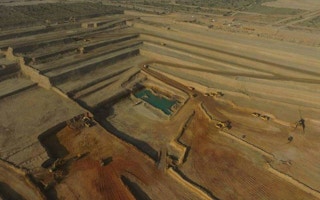A line of trucks weaves in and out of the open coal pit that has been dug in the Thar Desert in Pakistan’s southern Sindh province.
Below the massive hole lies one of the world’s largest coal reserves, untapped until now.
For years Pakistan used its Thar coal reserves as a bargaining chip in global climate negotiations. Since it was not mining the coal, it argued, it should receive easier access to international climate finance and to clean technology to help it grow in a cleaner and more sustainable way.
But as part of its attempt to end the country’s energy crisis which has caused frequent power cuts for years, the government is encouraging mining companies to the area.
Traditionally Pakistan has had relatively low emissions of climate changing gases. But under the global Paris Agreement to address climate change, the country has admitted it is likely to see a four-fold increase in emissions by 2030.
“
They will pump dirty water from the mine to store in the (reservoir) and that will pollute the sweet water in our wells. Engro is willing to give us money but we don’t want it.
Padma Bai, protester
The coal mine is set to become Pakistan’s biggest industrial site, said Shamsuddin Shaikh, head of the Sindh Engro Coal Mining Company (SECMC), a joint venture between the Sindh government and Engro Powergen.
The company is mining 1 per cent of the deposits in one of 13 investment blocks.
Coal is “the worst fossil fuel there is”, he told the Thomson Reuters Foundation. But “Pakistan needs electricity – its GDP is currently affected by the lack of power”, he said.
The estimated 175 billion tonnes of watery, low energy coal was first discovered in 1992 but because of its poor quality, most companies found it too costly to mine.
In 2012, SECMC, took up the challenge, convincing eight companies to join them, two of them Chinese.
They are also now building a 660 megawatt coal power plant nearby – which the company wants to increase to 3,300 MW by 2022 – and the Sindh government has improved roads and built an airport in the desert for the project.
The government has promised to end Pakistan’s crippling power outages in time for the 2018 elections, embarking on construction of new hydropower dams, coal-fired power plants and renewable energy projects.
Pakistani climate expert Qamar-uz-Zaman Chaudhry, currently advising the Asian Development Bank, said he has told the government “not to lock the country for the next 25 to 30 years into coal technology”.
“Our role as a responsible member of the global community in combating climate change needs to be fully taken into consideration,” he said.
Most of the world, including China, is moving away from coal-based power generation, Chaudhry said.
Under the Paris climate agreement, countries are meant to be shifting to clean, sustainable energy as part of global attempts to curb greenhouse gas emissions and prevent the worst impacts of climate change, from worsening droughts and floods to accelerating sea level rise.
“Surely the indications are that the time may not be far when … countries not following the green energy path would be penalised. Our long term planning should not be focused on coal,” Chaudhry told the Thomson Reuters Foundation.
Pakistan is not the only country using coal - one of the cheapest but also most polluting forms of energy - to help plug its growing energy needs.
Most new demand for coal-fired power stations is in Southeast Asia, although other countries including Bangladesh are also building new stations.
Water pollution, new homes
For the past three months villagers near the mine have been protesting SECMC’s mining plans, saying the project will pollute their water and threaten their ancestral lands.
The company plans to transport effluents from the watery mine via a pipeline into a reservoir which will cover at least 1,500 acres (600 hectares) of land once it is built.
This will be done for the next two and a half years to dry the mine, and then the water will be treated and re-used in the coal power plant. The pipeline, linking the reservoir to the coal mines 26 km away, is almost complete.
“They will pump dirty water from the mine to store in the (reservoir) and that will pollute the sweet water in our wells. Engro is willing to give us money but we don’t want it. This is our ancestral land and we won’t leave,” said Padma Bai, one of the villagers protesting the project.
Leela Ram, whose large home lies close to the reservoir, said it should be built nearer the coal mine.
“Why can’t they dump the water where there are no people?” she asked.
The villagers have filed a case in the Sindh High Court and applied for a stay order to block the reservoir’s construction. The court hearings are underway but construction goes on.
“I will go all the way to the Supreme Court if need be,” said Ram, who is leading the protest.
The company said the site originally planned for the effluents was the nearby Rann of Kutch salt marshes but since they are a Ramsar Site for migratory birds the natural depression of Gorrano was selected instead.
The company is providing alternative pasture for villagers living near the Gorrano reservoir, and building new homes, schools and healthcare facilities for two villages being relocated to make way for the mine and power plant, said Mohsin Babbar, the company’s media manager.
“This will be a benchmark project - and will set the standard for others,” said Shaikh, referring to the new homes, a planned 70 bed hospital and a training centre for the local people.
“Of course if they (villagers) are not happy, this project will not work,” he added.
This story was published with permission from Thomson Reuters Foundation, the charitable arm of Thomson Reuters, that covers humanitarian news, climate change, resilience, women’s rights, trafficking and property rights. Visit http://news.trust.org/climate.










